Dyslexia and dysgraphia – what’s the difference?

Many parents and teachers struggle to distinguish between specific learning difficulties that affect literacy skills. This confusion is made even worse when they have such similar names. While dyslexia is traditionally associated with reading, dysgraphia affects writing. Both are language disorders that can cause a child to struggle in the classroom, but they are separate conditions with unique neurological and behavioral profiles (1).
Children with dysgraphia may have trouble with letter formation and word spacing in handwriting. They can experience difficulty with written expression, from translating ideas into language, and organizing their thoughts, to using grammar, capital letters, and punctuation correctly. For students with dyslexia, it is often English spelling and sounding out words in reading that are problematic.
Brain imaging studies involving groups of dyslexic and dysgraphic individuals have shows different patterns of fMRI functional connectivity and suggested that the integrity of the white and grey brain matter is also unique for each group (2).
However, research has also indicated that both conditions cause left-hemisphere processing delays compared to children who are classed as 'typical' readers and writers (3). What complicates the situation further is that some children may co-present with both dyslexia and dysgraphia. It's also possible for a student to be struggling with ADHD and dysgraphia.
Keep in mind every learner is unique and no two individuals will have the same set or severity of symptoms. Depending on the difficulties a child experiences, classroom accommodations and strategy training can help.
Phonics and training with sight words can enhance reading fluency in dyslexia and certain dyslexia-friendly fonts may make printed words easier to read. For students with dysgraphia, it can be helpful to explore alternatives to handwriting, such as teaching kids to touch-type on a computer.
The earlier a specific learning difficulty is addressed, the better, as children with language based learning difficulties that go undiagnosed may quickly fall behind their peers. They are also at risk for developing low self-esteem and a negative attitude toward school and learning that can follow them well into adulthood.
Dyslexia
The British Dyslexia Association explains that "Dyslexia is a hidden disability thought to affect around 10% of the population, 4% severely." Dyslexia is not a measure of intelligence, it is simply the result of differences in the way the brain processes language. In fact, many individuals see their dyslexia as one of their greatest strengths.
It has even been associated with out of the box thinking, creativity and enhanced problem solving skills. Nonetheless, dyslexia also causes difficulties in identifying the sounds that make up words, which can lead to problems in reading and spelling. This is the result of issues with phonemic awareness or the ability to segment speech into its component sounds.
Spelling in English is further complicated by the opaqueness of the language. Words are not always spelled in the way that they sound and there are many exceptions to the rules.
Learn more about dyslexia strengths, spelling in English and helping students with dyslexia.
What is dysgraphia?
Dysgraphia can affect a child’s ability to form letters in writing. It can also affect their written expression and capacity to translate ideas into language. Children with dysgraphia may produce illegible written work. Letters can be malformed and words written across a page without attention to line and margin spacing.
Unfortunately, there are far fewer research studies of dysgraphia than dyslexia (4) so less is known about the causes. Given the amount of cognitive strain writing activities cause for children with dysgraphia, students may feel frustrated during classroom activities. They may miss out on the content of the lesson due to difficulties with note-taking. As is the case for many students with specific learning disabilities, performance on written quizzes and exams may not accurately reflect the child’s knowledge.
Learn more about strategies for individuals who have dysgraphia.
What dyslexia and dysgraphia have in common
Students with dyslexia and learners with dysgraphia regularly produce written work that is below their ability level. It can be quite messy and hard to read. Vocabulary use and spelling skills can be poor compared to peers. Students may also avoid activities that involve reading and writing, and can develop a lack of confidence and low self-esteem.
When spelling is particularly problematic, dyslexia can affect a child’s fluency in written expression in the same way that dysgraphia does. It may also affect the way they organize information within paragraphs and in their composition as a whole. Moreover, some students find their dyslexia interrupts letter formation and mimics the symptoms of dysgraphia. Learn more about dyslexia and how to tell dyslexia and visual processing difficulties apart.

Recognizing writing related difficulties
It's important to recognize language and fine-motor skills disorders that affect writing before they negatively affect a child's confidence and self-esteem. Here are some things to look out for:
Awkward posture and grip in writing
When writing problems are a result of poor muscle control or coordination of fine motor skills, such as in dysgraphia and dyspraxia, the physical act of gripping writing utensils can be painful. Students may hold their arms and wrists in an unusual way. Teachers will also observe uneven pressure applied with darker and lighter bits of text or a paper that slips out from under them and moves around the desk. Dyspraxia is not actually classed as a learning difficulty but it can affect students in the same way as dysgraphia does.
Written work doesn’t reflect knowledge or ability
If a student consistently underperforms in written exercises, it can be a sign of a specific learning difficulty. A child may use a limited range of words that doesn’t match their spoken vocabulary or they may not be able to express themselves in writing and provide answers in the same way as they can orally.
Inconsistent use of spelling, capitalization or punctuation
It can be frustrating to have a student spell words correctly one day, and not the next but this may be an indicator that a learning difficulty is present. Inconsistent spelling is commonly seen in dyslexia. The misuse of capital letters can also be a sign of dysgraphia or visual processing disorders and is sometimes related to difficulty in forming lowercase letters. Learn more about writing capitals vs. lower-case letters.
Avoidance of homework and written assignments
One of the most obvious signs of writing difficulties is a refusal to do homework or sit down to compose written work. Students may be overly fidgety or anxious before writing and they may act out or refuse to participate. Note that children who struggle with attention issues, such as those who have ADHD or ADD, may have difficulty getting started in writing and can benefit from brainstorming activities to help them get going.
Negative attitude towards school
Having a negative attitude toward school and learning can be a sign that a learning difficulty is present. Kids may feel embarrassed in front of their peers because of perceived deficiencies in writing, spelling or reading. They may be ashamed, lack confidence, and have feelings of low self-worth. Moreover, they may be lacking in the ability to get these feelings out through written expression and diary writing. This is why identifying a learning difficulty early on and providing appropriate classroom accommodations is so important.
Learn more about recognizing the signs of dysgraphia in children.

5 Tips for teachers
Here are some things to keep in mind when working with children and older learners who have dysgraphia and/or dyslexia.
-
Pay attention to the time of day. Avoid scheduling writing activities for the end of the day, after lunch, or any other time when students with specific learning disabilities are likely to be tired and have difficulty focusing. For learners with dyslexia and dyspraxia, reading and writing can be particularly draining and this is even more so the case if they are tired to begin with.
-
Keep writing tasks brief. In cases of severe dysgraphia, students will find the act of writing cognitively exhausting. Reducing the amount of text they are expected to produce can help. Schedule a shorter time slot for writing and/or provide frequent breaks so students can get up and walk around the room.
-
Focus on quality over quantity. Every word counts for a student who struggles with written expression. Judge them on the quality vs. the amount of text they produce to allow them to focus their attention on proofreading their work.
-
Allow exams to be taken orally. If reading and writing are a problem, an oral exam will often provide a more accurate assessment of a child’s knowledge and allow them to better demonstrate what they have learned. Additionally, dysgraphic students who are okay with reading may do better with multiple choice vs. short answer question types.
-
Teach touch-typing. Using the right typing program can reinforce phonics knowledge and harness muscle memory in the fingers to assist dyslexic students with spelling. Writing on the computer can also eliminate the physical strain of handwriting for children with dysgraphia. Additionally, it opens up access to spell checkers, grammar tools and outlining programs. Taking a multi-sensory approach to typing may be particularly effective for learners who struggle with language disorders.
Learn more about common handwriting problems in children and helping students develop strong writing skills.
TOP TIP: Touch-type Read and Spell is a multi-sensory touch-typing course designed to help students with dyslexia and dysgraphia boost their literacy skills.
Diagnosing dyslexia and dysgraphia
When a child struggles with literacy skills, it can have a spiral effect and impact on all areas of learning. Reading and writing are required across subjects and if dyslexia or dysgraphia have not been diagnosed, a child who turns in messy work with poor spelling, punctuation and organization may be told they are “lazy” or just not “trying hard enough.”
This is particularly tragic when students with learning difficulties have spent extra time and effort on an assignment but do not see an improvement in performance. Providing extra encouragement and finding new ways to motivate students can give children with specific learning difficulties the support they need to achieve their full potential in the classroom.
What about dyspraxia and visual processing disorders?
Dyspraxia is characterized by difficulty with fine motor skills. It can make it hard for students to use scissors and hold a pen or pencil in writing. Sometimes, using a thicker pen can help. As with dysgraphia, painful handwriting can be a frustrating experience that prevents children from focusing on the content of their composition. It also distracts from attention to spelling and punctuation.
Visual processing disorders interrupt the brain’s processing of visual information, including written language, and can result in irregularly shaped letters and words, as with dysgraphia.
Learn more in these articles on dyspraxia vs. dyslexia and visual processing disorders.
Share your story with us
Do you have experience teaching or parenting kids who struggle with language disorders that affect writing? How did you first recognize there was an issue? Please share any advice you have for supporting learners in the comments below. We look forward to hearing from you!
References
1) Berninger, V., Richards, T. & Abbott, R. (2015). Differential diagnosis of dysgraphia, dyslexia and OWL LD: behavioral and neuroimaging evidence. Reading and Writing, 28(8), 1119-1153.
2) Richards, T. L., Grabowski, T.J., Boord, P., Yagle, K., Askren, M., Mestre, Z., Robinson, P. Welker, O., Gulliford, D., Nagy, W. & Berninger, V. (2015). Contrasting brain patterns of writing-related DTI parameters, fMRI connectivity, and DTI-fMRI connectivity correlations in children with and without dysgraphia or dyslexia. NeuroImage: Clinical, 8, 408-421.
3) Mather, D. (2003). More than written langauge difficulties in common. Journal of Learning Disabilities, 36(4), 307-317.
4) Dohla, D. & Heim, S. (2016). Developmental dyslexia and dysgraphia: what can we learn from the one about the other? Frontiers in Psychology, 6.
For learners who struggle with dyslexia
TTRS is a program designed to get children and adults with dyslexia touch-typing, with additional support for reading and spelling.
Chris Freeman
TTRS has a solution for you
An award-winning, multi-sensory course that teaches typing, reading and spelling

How does TTRS work?
Developed in line with language and education research
Teaches typing using a multi-sensory approach
The course is modular in design and easy to navigate
Includes school and personal interest subjects
Positive feedback and positive reinforcement
Reporting features help you monitor usage and progress













